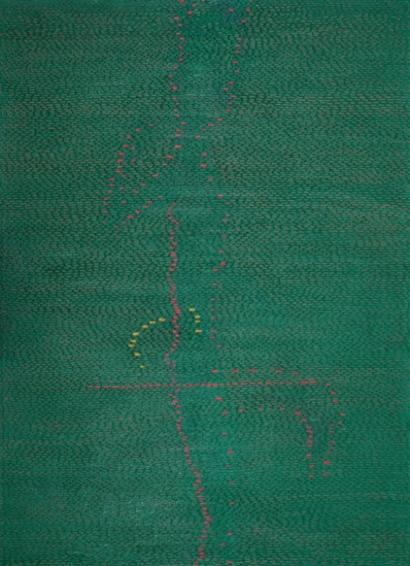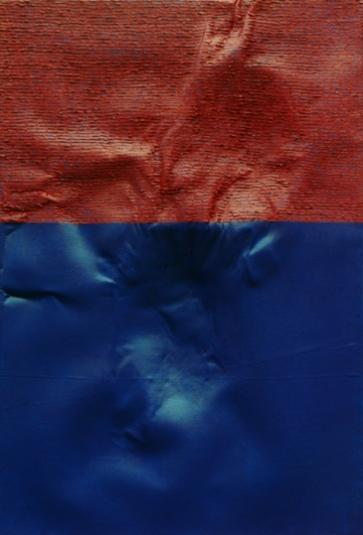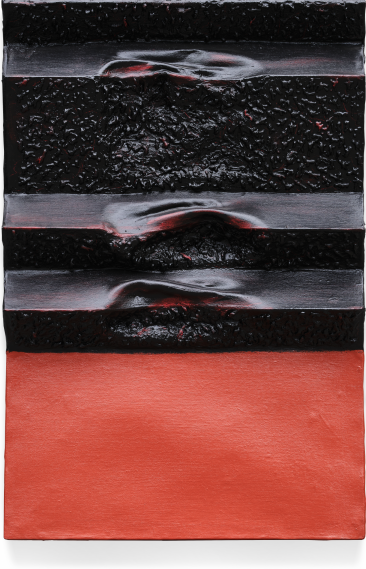


艺术不可承受:王小松作品展
策展人
张子康
学术主持
沈语冰
展期
2023.01.08-03.18
主办
信雅达文化艺术
承办
上空间艺术中心
协办
浙江大学艺术与考古学院
地址
上空间艺术中心
【中国(上海)浦东新区即墨路16号尚悦西街S1幢上空间艺术中心】
上空间开年大展「艺术不可承受」王小松作品展于1月8日正式拉开帷幕。浙江大学艺术与考古学院副院长、当代艺术设计研究所所长、教授、博士生导师王小松携新近创作的近三十件精品力作亮相上海。此次展览由中央美术学院美术馆馆长、教授、博士生导师、《美术馆》杂志主编张子康担任策展人,艺术史翻译家、复旦大学特聘教授、博士生导师、艺术哲学系主任沈语冰担任学术主持。与此同时,本次展览集聚业界大咖担任学术委员会成员,阵容空前强大,成员包括(按姓氏笔画为序):
王林,四川美术学院教授、策展人
王将,策展人
冯明珠,前台北故宫博物院院长、宝吉祥文史研究院院长
朱青生,北京大学教授、北京大学视觉与图像研究中心主任
杜曦云,艺术批评家、策展人
李子儒,中央美术学院艺术史博士
杨卫,艺术批评家、策展人,中国美术批评家年会秘书长
何桂彦,四川美术学院美术馆馆长,四川美术学院当代艺术研究所所长、教授
张晓凌,中国国家画院副院长,华东师范大学美术学院院长、教授
陈燮君,前上海博物馆馆长
周懿,自由策展人
高名潞,艺术批评家、当代艺术史学家、教授、策展人
黄文叡, 复旦大学泛海国际金融学院金融学实践教授、美国摩帝富艺术集团执行董事
黄石,独立作家
龚云表,艺术评论家
鲁虹,艺术评论家、当代艺术史学家、策展人,前深圳美术馆艺术总监
蔡彭城,上海奥赛艺术品经营有限公司董事长

艺术评论
Art Criticism
失控的意念,纠结的画面
——浅谈王小松绘画中的时间和空间美学
Unruly Thoughts and Crumpled Images
—— A Brief Discussion on the Aesthetics of Time and Space in Wang Xiaosong's Paintings

艺术不可承受—王小松作品展海报
凝视着维也纳艺术家美术馆的展览海报,一个疾驰前倾的身影,纵身迈步向左跨去,身后的发辫随之扬起,帽沿下半遮掩的脸庞,似乎感受得到他用力的呵气声,墙上映着他不成形的身影,空气中飘着一股躁动的气味,犹如暴走的灵魂在人间窜逃却无处可躲,这形态恰巧呼应了薄丘尼《独特的空间连续形式》,企图在静止中演绎速度,但这张海报里的人物却想在速度中追求静止,帮失控的情绪寻找心的方向。海报上不见任何作品,左下角的中文标题写着:王小松《失控的蚂蚁》。用“失控”两个字来形容艺术家矛盾、辩证、不妥协的创作动机,恰如其分,不仅是创作灵感的失控,也呼应了之后在平面画布创作上的失控。
On the exhibition poster hanged in the Vienna Artists Museum, a man is dashing forward, striding to the left, with the braid behind flying up and his half-covered face under the hat sensing his deep breath. With the shapeless shadow cast on the wall, and a smell of restlessness carried through the air, the image exclusively resembles an uncontrollable soul running away from the world only to find no place to hide. This picture responds exactly to Boccioni's Unique Forms of Continuity in Space, in which the figure is aerodynamically deformed by speed, while the figure on the poster is striving to pursue stillness in speed, assisting the uncontrollable emotions to find their inner direction. There is no artwork on this poster, but on the lower left corner of which writes its Chinese title: Unruly Ants by Wang Xiaosong. It couldn't be more appropriate than the word "unruly" to describe the artist's contradictory, dialectical and uncompromising creative motivation, which is also right to both his creative inspiration and the creation on the flat canvas.

王小松无位性
Atopic
130x108cm综合材料
2022年
王小松于2002年底从德国留学归国后,早期的创作风格仍停留在二维画布的探索上,《空层》(2010)和《失控的蚂蚁》(2012)便是此时期的代表,画面上线条如织,或成矩阵、或如人形、或成网状、或以文字乱码编排,密密麻麻地在平面画布上有序但不规律地编织着生命的符码,谱出了艺术家心中的哲学命题:生命的本质建构在有序的DNA和重组(失序)后所产生的异变。《五感》里的绿色,只是生命本质的一种铺陈,格子里填入的红和黄所编织出的点和线,才是驱动生命本质中五感的因子。
Wang's early creative style, after his return from Germany at the end of 2002, remains on the exploration of two-dimensional canvas, which is represented by the series of Empty Layer(2010)and Unruly Ants(2012). With lines crisscrossing on the canvas in the forms of matrices, human-figures, or networks, or garbled texts, he weaves densely the code of life in an orderly but irregular way on the flat canvas and composes a philosophical proposition in his mind: the essence of life is constructed in the orderly-mannered DNA and the mutation generated by recombination(disorder). The green color in Five Senses represents life itself, the dots and lines filled in the grid and woven by red and yellow are the factors that activate the five senses of life.

王小松 五感
Five Senses
160×220cm 油画
2006年
又如《轨迹》,以黑色矩阵编织成网,但每格黑框里所填进的红又跟黑产生不同程度的交融,当拉开视线,画面上的黑影有如鬼魅般的纠缠着本已受禁锢的红,氤氲沁漓,谱出一曲不安且多舛的命运交响乐。
As for Trajectories, it is woven into a net with black matrices, but the red filled in each frame has different degrees of integration with the black. While it is pulled afar, like ghosts the black shadows on the picture entangle with the imprisoned red, impressively composing a symphony of a hard and suffering fate.
这时期的作品,不管是以点线破坏面,还是在色调里做文章,或者像《抑郁者的情绪》,用不规则的红来破坏画面,皆试图在平面画布上探寻一个若即若离的空间感。之后,在《失落的幽灵》里,更以厚涂的重彩,勾勒出不成人形的幽灵,在阴郁的内心世界里苟延残喘,而那处混沌的蓝,正逐步堕向黑色的深渊;即使色彩明亮如《布达拉宫》的黄,画面上的人形仍摆脱不了灵魂在救赎前的挣扎与呐喊,而那些熬不住诱惑的躯体,已逐渐腐蚀败坏,形销骨毁,在画布上留下了无数的凹洞,这也是艺术家探寻空间的另一种形式,以色彩书写内容,以形式创造寓意。这个时期的作品是一种哲学性的思考,且在二维的画面上探讨空间的界限和延伸的可能性,直到2013年的《破界》,哲学性的思考逐渐升华为辩证,色彩从内容跨足到形式,平面画布的界限逐渐被打破,时间的概念若隐若现,王小松的创作又进入了另一个“失控”的时期。
The works of this period, no matter breaking the surface with dots and lines, or with colors, or irregular red as in Depression, are all seeking to explore a tentative space on the flat canvas. Later, in Lost Ghosts, with dark impasto strokes he sketches out formless ghosts struggling in their gloomy inner worlds, on which the chaotic blue is gradually falling into the abyss of black. Even with the color as bright as the yellow on Potala Palace, the human images still can't escape from struggling and screaming before the redemption of their souls, and those, who cannot resist the temptation, have gradually corroded and decayed, leaving nothing but countless concave holes on the canvas, which is another form of the artist's searching for space--endowing colors with content, and forms with meaning. The works of this period represent a kind of philosophical thinking, as he explores the boundaries and extension possibility of space on the two-dimensional picture planes. Up till Breakthrough of 2013, with his philosophical thinking gradually evolving into dialectical thinking, color-composed contents developing into color-composed forms, the edges of canvas plane slowly torn up, and the concept of time being indistinct, Wang Xiaosong's creation has entered another uncontrollable phase.

王小松 蠕动
Squirming
165x172cm 综合材料
2019年
画布作为一种平面媒材,已经辉煌地写下了400多年的历史,艺术家不断在二维的平面上尝试各种创新,企图创造一种新的空间概念,而15世纪文艺复兴时期的透视法,使画面有了景深,暂时满足了艺术家在二维画布上营造空间感的饥渴,例如米开朗基罗在西斯汀教堂的壁画,画面融入了繁复的建筑元素,凸显了人物在空间里的立体感;而此后的几百年中,学院派主掌了艺术史的书写,强调主题的教化功能和道德感,追求形式和内容的崇高性,不再一味探索画面中的空间感,直到20世纪初的立体派,毕卡索试图以另一种全观的视角,打破物象的基本结构,让支离破碎的画面营造出一种解构后再重造的内透感,而紧接着的拼贴技法,又让画面产生一种外放感。这一凹一凸、一缩一放的画面实验,在当时并没引起太多的关注和讨论,但在二次大战后却引发了另一场美学革命。美国抽象表现主义在战后独领风骚,其中以罗斯科为首的色域绘画,将色彩作为一种时间概念,企图在对比或互补的色块交融中,寻找一种精神层面的空间感,且在这空间里塑造最大的时间效应。后来意大利艺术家卢奇欧·封塔纳又将这时空观念进一步引申,以割破平面画布来制造三维的空间,然画布上单彩的背景色,更是记忆的另一种呈现,记忆不外是一种时间概念,当时间发酵覆盖了整件作品,便逐步将之升华为四维的创作。几百年来,艺术家在画布上的实验,每每在艺术史上留下了印记,寻着前辈的足迹,在反叛与继承中,艺术家一味追求的,不外是在平面画布上所展现的时间和空间概念。而王小松的创作在《破界》系列之始,便已展开了一连串时间和空间的实验。
Canvas, as a kind of planar media, has brilliantly reigned over 400 years of art history. Artists have been consistently making various innovations on the two-dimensional picture plane, attempting to create a new concept of space. Renaissance perspective in the 15th century provided the picture with depth of vision, temporarily quenching the thirst of building space on the plane of canvas, as was illustrated by Michelangelo's fresco in the Sistine Chapel which integrated complex architectural elements into the pictures, highlighting the three-dimensionality of the figures in space. In the following several hundred years, the academic art dominated the art history, emphasizing the ethical and moral functions of art, pursuing the loftiness of form and content, and ceasing the exploration of space on canvas. Until the emerging of Cubism in the early 20th century, Picasso started to take a different perspective by breaking the basic structure of the images. The multifaceted picture created an inward perspective after deconstruction, while the following collage technique gave the picture an outward release. This picture experiment of concave and convex, contraction and expansion did not raise too much attention and discussion at that time, however, it triggered another aesthetic revolution after the World War II. American Abstract Expressionism became a dominant trend after the war, among which the Color Field headed by Rothko applied colors to represent the concept of time. With the juxtaposition of large area of melting colors, he tried to seek a spiritual space, in which to construct a maximum volume of time effect. Later, the Italian artist Fontana further developed this concept of time and space by cutting a picture plane to create a three-dimensional space. However, the monochromatic color background on the canvas is a representation of memory, which is nothing more than a concept of time. When the fermentation of time covered the whole work, it gradually evolved into a four-dimensional creation. For hundreds of years, artists' experiments on canvas have left trails on the history of art. By following the footsteps of their predecessors and through succession and rebellion, artists have been persistently pursuing the concept of time and space displayed on the plane of the picture. Since the beginning of Boundary Breaking series, Wang Xiaosong has been starting the exploration on time and space.
《破界》里的首张作品《床》,用红蓝两色把画布一分为二,蓝色往上推移,让红色显得窘迫,艺术家利用色彩制造了界限,但又利用画布上的皱褶打破了红蓝的界限,让空间得以在色彩里延伸出来,藉此寓意留在床上的躯体和温度,巧妙勾勒出了记忆中的时间概念。
The picture of Bed, the first work of Boundary Breaking series, is divided by red and blue. The red seems embarrassed as the blue pushing up. With colors the artist sets a boundary, yet with wrinkles he breaks this boundary and releases the space through colors, to represent the earlier body and its warmth left behind and, at the same time, skillfully sketch out the time in memory.

王小松 床
bed
100×150cm 油画
2013年
而2015年的《舞姿》,更把画布形塑成阶梯,让足迹深深地崁入蓝色的阶梯上,随着扭动且带着韵律的足迹,幻化为美妙的舞姿!有了《舞姿》的大胆尝试,王小松手里的画布开始有了更大胆的翻转,几乎皱成一团纠结成块的画布,成了一幅幅《无题》的雕塑绘画,平面被打破了,三维于焉形成,而单色彩的张力更唤醒了观者的过往记忆,时间跃然画布上,穿梭在崎岖不平的空间里,诉说着道不尽的过去、现在与未来!
In Dancing of 2015, the canvas was shaped into a staircase, with footprints embedded deep in the blue steps. The rhythmically twisted footprints were transformed into a graceful dance! With the bold try of Dancing, Wang Xiaosong launched an even bolder revolution, the canvases crumpled into virtually tangled clumps became a series of Untitled sculpture paintings. The plane was broken and three-dimensionality came into being. The tension of the monochromatic color scheme awakes the viewers' memories, time leaping on the canvas, shuttling in the rugged space, talking about their endless past, present and future!

王小松 舞姿1
Dance 1
150×100cm 综合材料
2015年
而2020年的作品,在皱折的画布上更发生了色彩的变化,让原本单色彩的张力瞬间转化为一股强大的凝聚力,不仅是画龙点睛制造新意,更紧紧抓住了观者的视线,让人思索着破坏重构后的新语境。其中《向罗斯科致敬》,让金属靛蓝和橘红透过皱褶交融,在三维空间中让色彩产生对话,透过对话直接联系了时间,但时间不因空间而存在,因为在创造空间的过程中,时间早已悄然形成,只是透过了色彩,让时间的流逝跃然画布上,这点恐怕连罗斯科都望其项背。
His works of 2020, brought color changes on the crumpled canvas, transforming instantly the original single-color tension into a powerful cohesive force, which does not only make something new by a wonderful finishing touch, but also attracts the viewers' attention and encourages them to think about the new context born in the deconstruction. In respect to Rothko, the metal indigo blue and orange blend through wrinkles, and colors converse in a three-dimensional space. In the conversation time is straightly involved, but time does not exist because of space, since in the process of space creation, time has already come into being. But only through colors, the passing of time could leap onto the canvas, which I am afraid even Rothko is falling far behind.

王小松 向罗斯科致敬
RespecttoRothko
105×115cm 综合材料
2020年
王小松的创作始于“失控”,也因“失控”继续前行,十几年来各个不同的风格期,从二维到三维,从思索到辩证,从继承到反叛,再加入时间与空间的对话,一路走来,不安于前人的建树,挑战着自己的现在,也期盼在未来的绘画美学上立竿见影。从一张海报的设计,见微知著,艺术家的心思缜密且独具创意,希望在失控之余,期待王小松在时间和空间的挑战上,能有更颠覆的操作与创新。
Wang Xiaosong's creation begins with unruliness, and thanks to unruliness he could continue to push forward. He has experimented different styles over the past decade, from two-dimensionality to three-dimensionality, from philosophical inquiry to dialectical exploration, from succession to rebellion, then he invites the dialogue between time and space onto the canvas. He is not satisfied with the legacy of the predecessors, but keeps challenging his present being and expects to be prominent in the future. The design of the poster reveals a bigger picture of the artist's thoughtfulness and creativity. I anticipate that Wang Xiaosong will go beyond unruliness and launch more revolutionary performances and innovations on the exploration of time and space.【文/黄文叡 复旦大学泛海国际金融学院金融学实践教授,美国摩帝富艺术集团执行董事、资深合伙人,世界重要私人、企业、基金会、欧洲和中东皇室艺术收藏顾问 上空间(Text/Terry Huang Executive Boardmember and Senior Partner of Motif Art Group in the USA,Advisor to the world's leading private foundations,royal art collections in Europe and the Middle East,Practice Professor of Fanhai International School of Finance,Fudan University ArtSun Space) 】

王小松 灵魂与肉体
Soul and Body110×108cm
综合材料 2021年
艺术家简介

王小松,1964年出生于中国武汉,1987年本科毕业于中央工艺美术学院,1997年大师生毕业于柏林艺术大学。
现任浙江大学艺术与考古学院副院长、教授、博导,浙江大学当代艺术设计研究所所长。
重要个展(节选):
2019 新浪漫波普一王小松个展 宝吉祥艺术中心,台北、上海
2013 破界一王小松新作展 美第奇·里卡尔第宫,佛罗伦萨,意大利
2012 失控的蚂蚁一王小松个展 欧洲巡展
维也纳艺术家博物馆,奥地利;科布伦茨路德维希美术馆,德国;吕贝克圣安娜美术馆,德国
参展(节选):
2022 游目骋怀一旅德中国艺术家作品展 国家大剧院艺术馆,北京
艺以通衢一2022武汉双年展 武汉美术馆(琴台馆),武汉
NordArt 2022 国际艺术展 NordArt 现代艺术博物馆,德国
2020 中国表现一第一回展 华泰顶层艺术社区,上海
2019 第八届中国北京国际美术双年展 中国美术馆,北京
历史的凝视:再访中国当代艺术 木星美术馆,深圳
2017 中国一对话 科布伦茨路德维希美术馆,德国
2016 互补与契合一中国留学德国艺术家作品展 刘海粟美术馆,上海
主要策展:
盛世修典——“中国历代绘画大系”全国巡展
出版物(个人作品集):
2021 《印如精舍珍藏王小松》 台湾盈记唐人工艺出版社
2013 《破界:王小松新作品集》 意大利 Palazzo Medici Riccardi出版社
2012 《失控的蚂蚁:王小松作品集》 德国Hirmer出版社
2010 《空层:王小松作品集》 湖南美术出版社
2003 《王小松作品集1992-2002》 德国Hentrich&HentrichVerlag出版社
